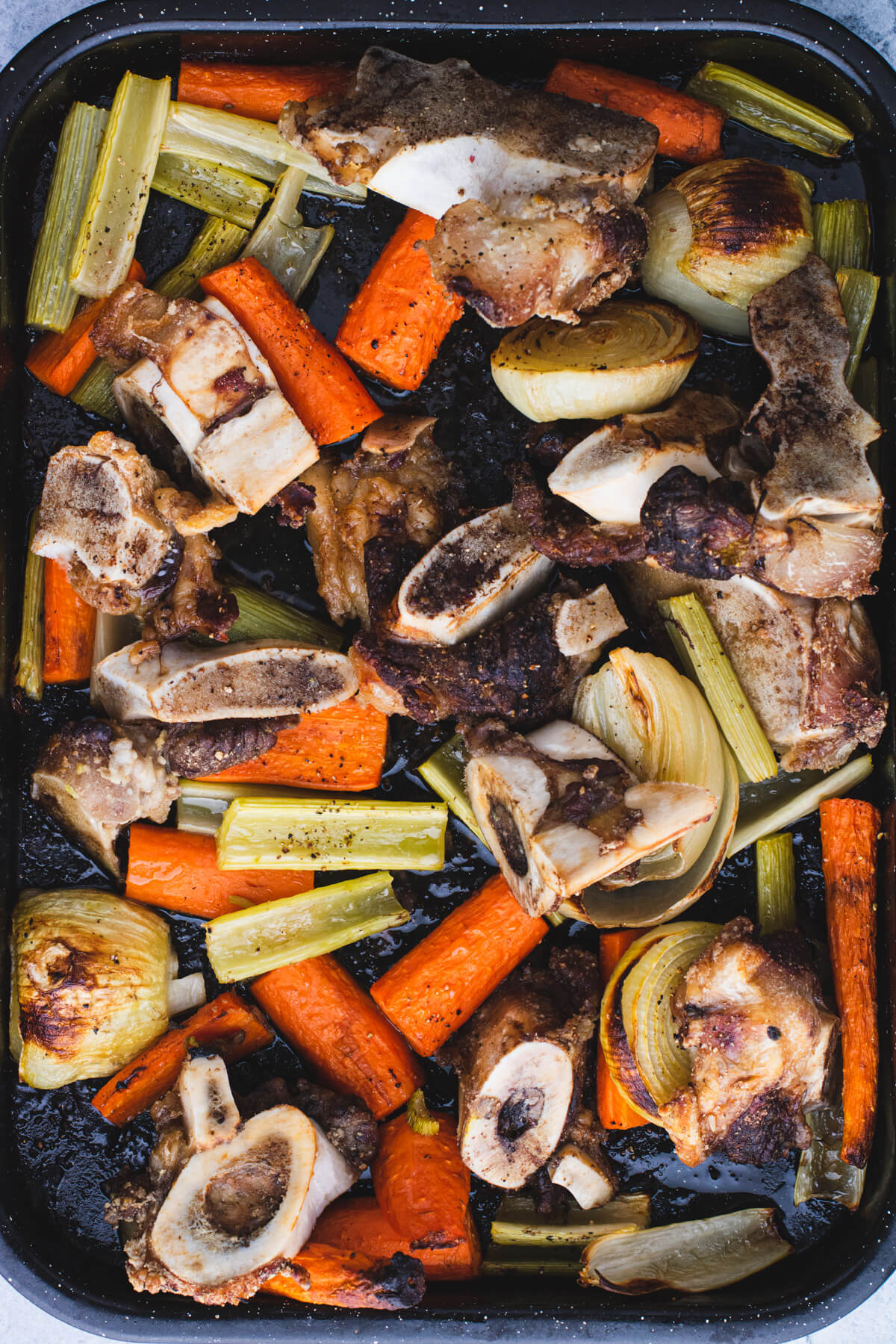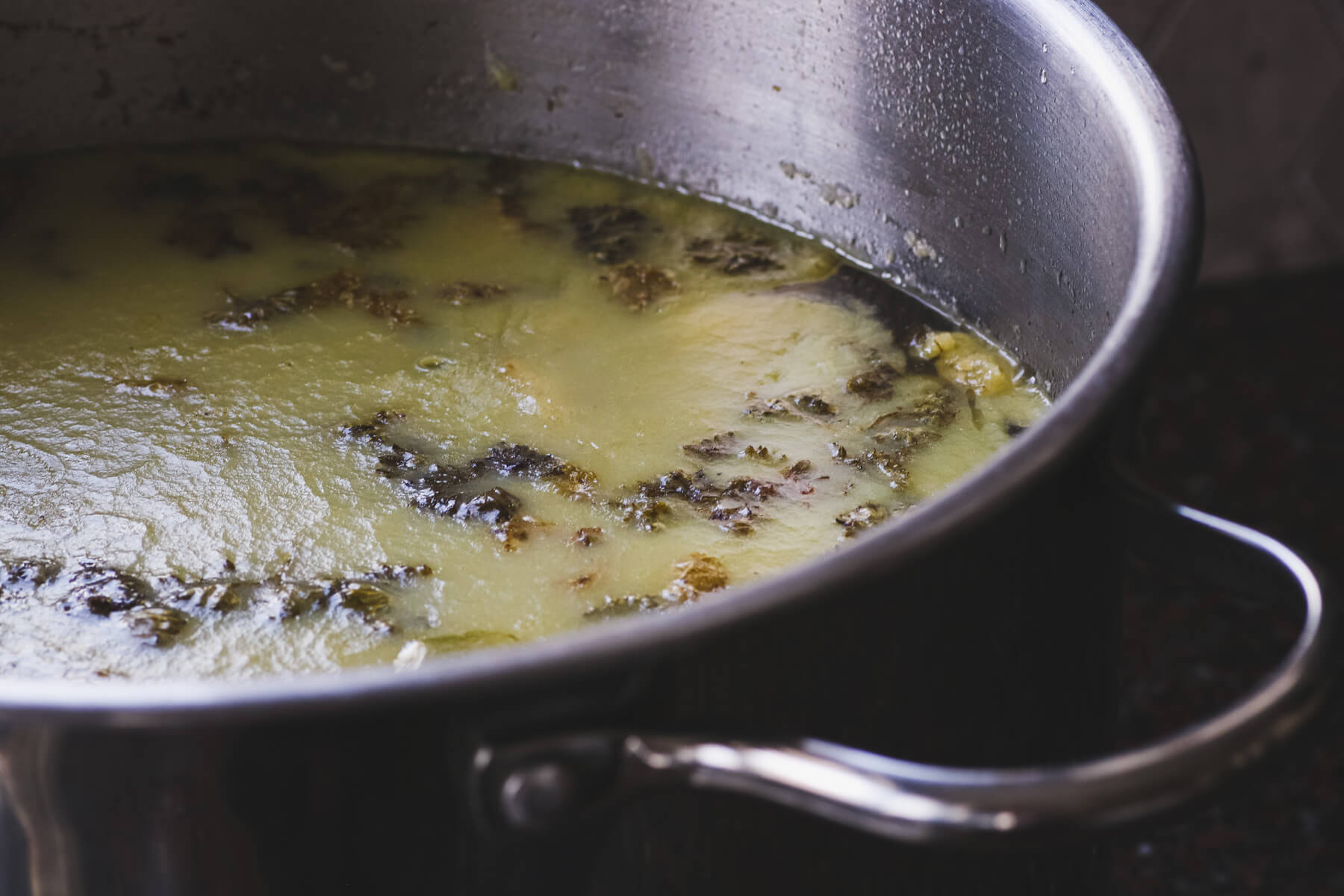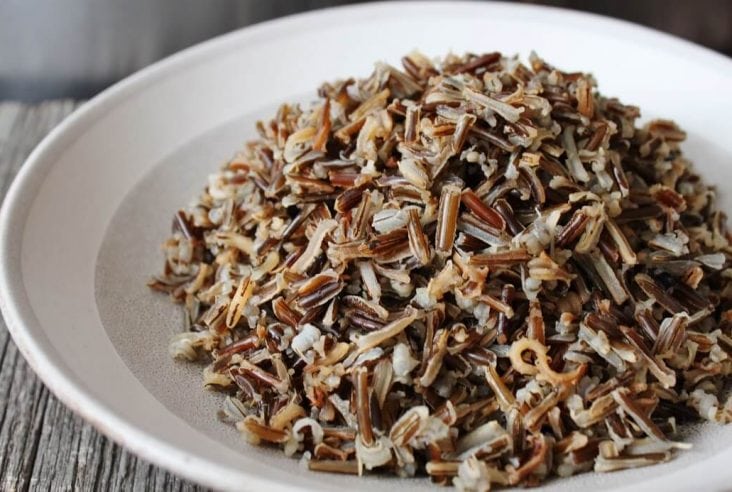Want to know the secret to making a rich, luxurious beef stock? Follow these easy steps, tips, and tricks to make great beef stock at home. This essential ingredient is the foundation of so many soups, stews, and braises. Note: Recipe time includes an overnight chill and cooking time may vary.
Slow food is good food. There’s nothing more satisfying than putting that No Knead Whole Wheat Bread in the oven after an overnight ferment. Garlic Dill Pickled Carrots are even more delicious when you know that you have put the effort in to preserve them yourself. There is just no substitute for time and effort when it comes to great food.

Want to save this recipe?
Enter your email below and get this post sent straight to your inbox. Plus, I’ll send you my weekly newsletter featuring the newest and best Dish ‘n’ the Kitchen recipes every week!
Homemade Beef Stock
There’s no shying away from the truth; great homemade beef stock takes time. The good news is that stock making is a very satisfying weekend project with a delicious end reward. Most of the time listed for this recipe is ‘hands-off’, meaning the stock simmers away (or chills) while you do other weekend things.
The key to a flavourful, well rounded beef stock is roasting the bones and vegetables before letting them simmer in a long hot bath. Roasting promotes caramelization and caramelization always equals extra flavour. Believe me, this beef stock recipe is one for the books and it is so much better than stock from grocery stores.
Once you make the stock, you’ll want to drink it by the mugful. However, if you can resist, you’ll find a long list of delicious recipes to use it in. Think Beef Barley Soup, Beef and Pepper Soup, French Onion Soup, Beef Stew or the classic Beef Bourguignon. It’s great as a substitute for chicken broth in a beefy risotto or added to dishes such as Braised Beef Short Ribs.

Beef Stock vs. Beef Broth
Most cooks use stock and broth interchangeably. However, they are technically two different liquids made by two slightly different techniques. Well made stock has a gelatinous texture when cooled. It will be clear, never cloudy and free from impurities. Broth is much thinner with a less intense flavour.
These two savoury cooking liquids are made by simmering ingredients (bones/meat, some vegetables, and aromatics) in water. However, stocks have a more intense flavour, due to the longer simmering time. Stocks are generally bone based (beef, chicken, fish) while broths are mostly made with meat (except vegetarian broth). The flavour and texture in stock comes primarily from collagen-rich marrow, meat, and connective tissue.
However, it’s not always about the meat. Most stock/broth recipes also include a mirepoix; otherwise known as carrots, celery, and onions. You can use saved and frozen veggie scraps or use the vegetables languishing in the fridge, as I often do. Other vegetables may be added to the simmer pot, however some may add undesirable flavours to your final stock (I’m looking at YOU, cruciferous vegetables!)
Want an even more flavourful stock? Add aromatics such as cloves of garlic, peppercorns, bay leaves, parsley, and thyme or rosemary.

Ingredients
Many people save carrot and onion peels (and other vegetable trimmings) in the freezer and make stock when the bag is full. I tend to make stock when I find a good deal on beef soup bones and have celery languishing away in my fridge. It doesn’t take a lot of ingredients to make beef stock. The flavour is all in the time and technique.
- Beef Soup Bones
- Carrots
- Celery
- Onions
- Salt and Pepper
- Olive Oil
- Water
- Garlic
- Bay Leaves
- Peppercorns
- Parsley
- Thyme
- Eggs
Soup bones are bones that are leftover after the butcher removes most of the meat. There may be still some meat left on the bones, however it is the marrow and connective tissue that supplies the stock with extra flavour and collagen. Buy marrow bones such as neck, shin, or knuckle bones for best results.

You can use carrot peels or carrots that have gone a bit soft for stock making. I’ve even added leftover cooked carrots to the mix. Carrots are 1/3 of the trio that make up a mirepoix.
Onion peels, soft onions, or even those that might have a little mold on them are fine to use in stock (cut off the mold first!). This aromatic allium is the second vegetable of the trio in a mirepoix.
Celery is another vegetable that one often finds languishing in the bottom of the fridge. Throw this final mirepoix vegetable in stocks and feel great that you didn’t throw out $1.50 worth of celery.
Garlic is a personal choice when making beef stock. I usually add it because I really love garlic. If you don’t love garlic you can reduce the amount by half or omit it altogether.

Lastly, let’s chat aromatics. Many cooks will add a bouquet garni to the stock. A bouquet garni is a bundle of aromatics such as herbs and peppercorns that is placed in a simmering stock. Typical bouquet garni ingredients include peppercorns with fresh or dried thyme, bay leaf, parsley, and rosemary (which I only add to chicken stock,not beef stock).
However, since we are straining this stock later on, there is no need to add the aromatics in a bundle, just add them to the stock pot and worry about it later.
The amount of water you add will depend upon the size of your stock pot. For a small size, many recipes suggest adding enough to cover the bones, plus a little more. In this case, the amount of reduction time will be greatly reduced. Always taste to decide when the stock has reduced to your liking.
For my stock pot (which is 3.5 gallons/12 liters), I doubled that amount. You can see from the photo that the liquid level is roughly 4 inches from the top of the pot.
Finally, eggs are not an essential stock ingredient. However, they are part of the technique used to remove impurities from the stock.

How to Make Beef Stock
This recipe has four main stages; roasting, simmering, reducing, and clarifying.
Roasting Bones and Vegetables
Preheat oven to 375 F. Place the roughly chopped veggies/trimmings in a bowl and drizzle olive oil to coat. Add them to a large roasting pan. Next, add the beef bones, trying not to crowd the pan too much. Heat circulation allows the ingredients to become more evenly caramelized.
Roast the bones and veggies in a 375 F oven for 30 minutes, then stir them around and roast another 20-30 minutes.
Transfer them to a large stock pot. Add a few cups of hot water to the roasting pan and place on the stove. Simmer and scrape all the browned bits off the bottom of the pan and add it all to the stock pot. Try not to leave any of the good stuff behind!

Simmering
Add enough cold water to cover the bones, then double that amount so that the liquid is roughly 4 inches from the top of the pot. Next, add garlic cloves, bay leaves, peppercorns, parsley, and thyme to the stock pot.
Cover the stock pot and allow it to come to a full boil. Reduce the heat and allow the stock to simmer for 6-8 hours. Remove and chill for 8-10 hours, or until the fat layer congeals on the surface of the stock.
Reducing
Carefully skim the top layer of fat off the chilled stock. Strain stock through a fine mesh strainer into another pot (you may need to use several pots). Place the bones/vegetables in the strainer and allow them to drip for ten or so minutes.
Wipe the stock pot out, ensuring no large chunks remain. Pour all the strained stock back into the pot. Cover and bring to a boil over medium high heat. Uncover and reduce the heat so that the stock is barely simmering. Allow it to simmer, uncovered for 4 hours. Add 1 tablespoon of salt, and taste the stock.

You decide when the stock has finished reducing based upon how concentrated you want your stock to be. For this reason, you may or may not end up with a full 8 cups of beef stock.
How to Clarify Beef Stock
Even though you strained the stock through a fine mesh strainer, there will still be impurities in the reduced stock. A simple way to remove them is to build an egg raft. Whisk 2 egg whites with 1/2 cup cold water and stir the foamy egg whites into the hot stock. Stir and allow it to boil.
As it boils, the eggs cook and take the impurities with them. Once all the egg has coagulated, strain the stock through a metal strainer lined with four layers of cheesecloth.
Congratulations…you have made a beautiful, collagen rich beef stock!

How to Store Beef Stock
Beef stock can be stored in the fridge for up to four days. I freezes really well too. I suggest reusing plastic 1 litre takeout containers so you can use that exact amount of stock directly in soups and stews.


If you make this Homemade Beef Stock recipe, please be sure to leave a comment and/or give this recipe a rating! Be sure to follow me on Facebook and Pinterest for my latest recipes. Also, if you do make this recipe, please tag me on Instagram, I’d love to see what you guys are making! Thank you so much for reading my blog.
How to Make Beef Stock

Want to know the secret to making a rich, luxurious beef stock? Follow these easy steps, tips, and tricks to make a great beef stock at home. This essential ingredient is the foundation of so many soups, stews, and braises. Note: Recipe time includes an overnight chill and reduction time may vary.
Ingredients
- 3 lbs beef soup bones
- 4 large carrots
- 5-6 stalks celery
- 3 medium onions
- salt and pepper
- Olive oil
- 5-6 cloves garlic
- 3 bay leaves
- 1 cup fresh parsley with stalks
- 1 Tablespoon peppercorns
- handful thyme leaves
- water
- 2 egg whites
Instructions
Roasting Bones and Vegetables
- Preheat oven to 375 F.
- Place the roughly chopped veggies/trimmings in a bowl and drizzle olive oil to coat. Add them to a large roasting pan.
- Add the beef bones, trying not to crowd the pan too much.
- Roast the bones and veggies in a 375 F oven for 45 minutes, then stir them around and roast another 15-20 minutes.
- Transfer them to a large stock pot. Add hot water to the roasting pan and place on the stove.
- Simmer and scrape all the roasted bits off the bottom of the roasting pan and add it all to the stock pot.
Simmering the Beef Stock
- Add enough cold water to cover the bones, then double that amount so that the liquid is roughly 4 inches from the top of the pot.
- Add garlic cloves, bay leaves, peppercorns, parsley, and thyme to the stock pot.
- Cover the stock pot and allow it to come to a full boil. Reduce the heat and allow the stock to simmer for 6-8 hours.
- Remove from heat and chill for 8-10 hours, or until the fat layer congeals on the surface of the stock.
Reducing the Beef Stock
- Carefully skim the top layer of fat off the chilled stock.
- Strain the stock through a fine mesh strainer into another pot (you may need to use several pots). Place the bones/vegetables in the strainer and allow them to drip for ten or so minutes.
- Wipe the stock pot out, ensuring no large chunks remain, then pour all the strained stock back into the pot.
- Cover and bring it up to a boil over medium high heat. Uncover and reduce the heat so that the stock is barely simmering.
- Allow it to simmer, uncovered for 4 hours. Add 1 tablespoon of salt, and taste the stock*.
How to Clarify Beef Stock
- Whisk 2 egg whites with 1/2 cup cold water and stir the foamy egg whites into the hot stock. Stir and allow it to boil.
- Once all the egg has coagulated, strain the stock once more through a metal strainer lined with four layers of cheesecloth.
Notes
*You decide when the stock has finished reducing based upon how concentrated you want your stock to be. For this reason, you may or may not end up with a full 8 cups of beef stock.
Nutrition Information:
Yield:
8Serving Size:
1Amount Per Serving: Calories: 232Total Fat: 12gSaturated Fat: 3gTrans Fat: 0gUnsaturated Fat: 7gCholesterol: 32mgSodium: 146mgCarbohydrates: 21gFiber: 6gSugar: 7gProtein: 13g
Nutritional calculation was provided by Nutritionix and is an estimation only. For special diets or medical issues please use your preferred calculator.





This looks amazing and the trick with the egg whites is knowledge I didnt have. Please can you tell me why you do not roast the garlic as well?
Thank you!! You totally could roast the garlic if you wanted to. No particular reason I didn’t.
Used 12lbs of beef bones so basically quadrupled recipe. After condensing I ended up with 9 quarts of the most delicious beef stock I’ve ever tasted! It’s currently in the pressure canner but I’m excited to use it in my recipes.
Great idea… yes, it’s such an easy recipe to scale up and I always say, the more stock you have the better! I love that you are pressure canning it too. I wish I could do that because my freezer is so full of stock!
When do you add salt to this recipe? ( I have already roasted and am now simmering)
Hey there, great catch. I usually add the salt and pepper to the bones before roasting but really, you can add it anytime. I left it open ended because often, I don’t add any salt at all. That way I can season when I make soup or whatever recipe I’m using it in.
Great post! I learned so much about stock and broth!
You are welcome Terri. Thanks for stopping by.
So many things that I am buying that I can be making at home!! I can’t believe I have never thought of making this myself! Bookmarked for later, thanks so much for putting this together!!
I hope you give it a try Cathleen, it’s so much tastier than store bought.
This is a fabulous recipe for beef stock! When I have time to make it, it’s so much better than using store bought.
Agree! It does take a long time but it’s mostly hands off time.
Great recipe! I make chicken stock allllll the time, but I don’t usually make beef stock because I don’t have beef bones around very often. But I clearly need to go out and get some, because you build the flavours so nicely here, and all that oven-roasted goodness is just perfect. Now to figure out pressure canning so I can make a whole bunch and keep it shelf stable. One project at a time I guess. Lol.
I was actually having a difficult time finding beef soup bones for a while. I finally just started ordering them from a local butcher.
This beef stock turned out perfectly! The process really is easy, and it’s so much more flavorful than anything you could buy.
So true! Glad you gave it a try Amanda.
I am SOOOOO excited that I found this recipe! I make my own chicken bone broth but I’ve never made my own beef bone broth! I just printed this recipe and I’m going to make it this weekend! SO happy I found this! It looks so easy and delicious!
Great to hear Amanda, hope it goes well for you.
thanks for the super detailed post. it turned out perfectly delicious!
So great to hear Nancy! Now, what are you going to use the stock for?
Roasting bones makes such a big difference when making stock. Yours looks so rich and delicious!
I feel like roasting is definitely the way to go.
Ohh! This was perfect for the Irish Stew that I made this weekend! It was so delicious!
We had stew last night too! The stock makes it extra beefy.
Beef stock is such a good staple to keep on hand. We use it ALL the time. Love how easy this recipe is.
It’s quite handy to have around. Glad you enjoyed the recipe.
It’s great to have homemade stock on hand. It can be used in so many delicious recipes. So much better than bought stock at the grocery store.
For sure. I’ve made three dishes from it so far. French Onion Soup, French onion soup pasta, and beef stew!
I’m always having to use beef stock for recipes I make, so I decided to make a big batch of this. It was so easy to do following your recipe and now I have plenty for my future cooking sessions.
So great to hear. You are ready to make so many delicious dishes now.